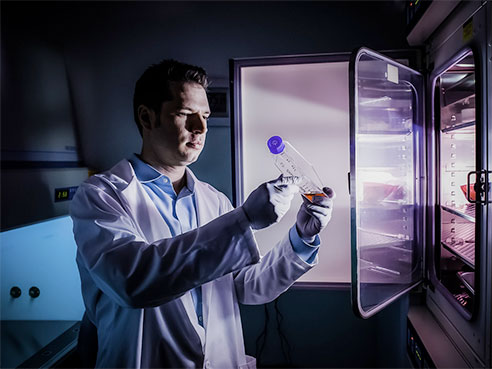
Now, research by Andrew West, Ph. D., and colleagues at the University of Alabama at Birmingham has revealed that the tubes hold a
«Nobody thought we’d be able to measure the activity of this huge protein called LRRK2 (pronounced lark two) in biofluids since it is usually found inside neurons in the brain," said West,
A biomarker helps physicians predict, diagnose or monitor disease, because the biomarker corresponds to the presence or risk of disease, and its levels may change as the disease progresses. Validated biomarkers can aid both preclinical trial work in the laboratory and future clinical trials of drugs to treat Parkinson’s. West and others are paving the way for an inhibitor drug that prevented neuroinflammation and neurodegeneration in an animal model of the disease, as reported last year by West and colleagues.
The new biomarker findings were published in Neurology in March and Movement Disorders in June. The biomarker, LRRK2, has been shown to play a role in hereditary Parkinson’s, and the most common of these mutations — called G2019S — causes the LRRK2 kinase to add too many phosphates to itself and other proteins. Why this leads to Parkinson’s disease is not yet clear.
The key to West’s biomarker approach was the recognition that LRRK2 can be purified from a new type of vesicle called exosomes found in all human biofluids, like urine and saliva. Cells in the body continually release exosomes that contain a mixture of proteins, RNA and DNA derived from different kinds of cells. West and colleagues were able to purify exosomes from 3- or
The findings
In the Neurology study, they found that elevated phosphorylated LRRK2 predicted the risk for onset of Parkinson’s disease for people carrying a mutation in LRRK2, which is about 2–3 percent of all Parkinson’s disease patients. These findings were first tested with a preliminary,
The
Next steps
Questions remain for this evidence of biochemical changes in LRRK2 in idiopathic Parkinson’s disease. One is finding out where the urinary exosomes come from. Given a suspected role for inflammation in Parkinson’s disease, it is interesting that LRRK2 is highly expressed in cells of the innate immune system. A possible explanation for the phosphorylated LRRK2 in patients with more severe disease may be an increased inflammation in those patients who have aggressive progression of disease.
In May, West was awarded a new U01 collaborative grant from the National Institute of Neurological Disorders and Stroke to further explore urinary exosomes and extend the observations to
Besides West, authors of the Neurology paper, «Urinary LRRK2 phosphorylation predicts parkinsonian phenotypes in G2019S LRRK2 carriers," are Kyle B. Fraser and Mark S. Moehle, of the Center for Neurodegeneration and Experimental Therapeutics and Department of Neurology, UAB School of Medicine; and Roy N. Alcalay, M.D., Columbia University Department of Neurology.
Besides West, authors of the Movement Disorders paper, «Ser(P)-1292 LRRK2 in urinary exosomes is elevated in idiopathic Parkinson’s disease," are Fraser, Ashlee B. Rawlins, Rachel G. Clark and David G. Standaert, M.D., Ph. D., of the UAB Center for Neurodegeneration and Experimental Therapeutics and Department of Neurology; Alcalay; and Nianjun Liu, Ph. D., Department of Biostatistics, UAB School of Public Health.
Source: http://www.uab.edu/news/innovation/item/7419-parkinson-s-disease-biomarker-found-in-patient-urine-sa...


